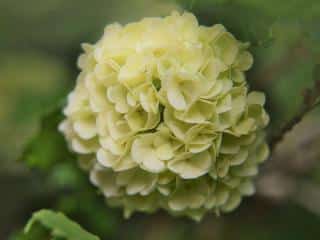

An amazing blooming, beautiful leafage, ornamental fruits… Birds and insects love Japanese snowball. And we do, too!
On top of its amazing flowering, the silhouette of viburnum plicatum is also appealing in itself. The architecture that the staged branches present is extremely rare in the plant world and make this a very distinctive plant. This remarkable shape is highlighted during the blooming thanks to the wide flat umbels or the round corymbs that unfold. This teleports us in mind to Japanese gardens and their cloud-shaped trees.
 Because of their extremely thin root system, Japanese Snowball doesn’t cope well with either extreme drought or waterlogged soil. This also makes it rather vulnerable to transplant shock. Rich, soft, deep, humus-rich and rather acidic soil produces the best results. Consequently, prepare the soil very diligently when proceeding to plant, and add as much organic matter as you can. This is the key to succeeding.
Because of their extremely thin root system, Japanese Snowball doesn’t cope well with either extreme drought or waterlogged soil. This also makes it rather vulnerable to transplant shock. Rich, soft, deep, humus-rich and rather acidic soil produces the best results. Consequently, prepare the soil very diligently when proceeding to plant, and add as much organic matter as you can. This is the key to succeeding.
Plant in fall or at the beginning of spring preferably from a specimen grown in a container and already standing at least 16 inches (40 cm) to 3 feet (1 meter) tall. Japanese snowball appreciates veiled light, and soil that stays cool in summer. Planting it near a tree with small leaves will give it light shade which is perfect. In areas where the sky is often covered, planting in a clear spot is possible. Strong direct sun is not well coped with. As for the climate, the best areas are seaside venues with mild temperatures all year long. In case of strong heat, water abundantly in the evening and even shower the leaves.
 Pruning is useless since the plant grows symmetrically and regularly.
Pruning is useless since the plant grows symmetrically and regularly.
Simply remove dead wood at summer’s end.
In smaller gardens or if you want to grow your snowball bush in a garden box, you can eventually shorten the branches after the blooming.
Can the Japanese snowball grow as a houseplant?
Hi Nancy, it can, in the same way that hydrangea is often cared for as such. However, it isn’t ideal since the Japanese snowball needs a time of dormancy. During the winter months, it helps to keep the shrub in a cool greenhouse, since otherwise it won’t bloom as beautifully in spring.